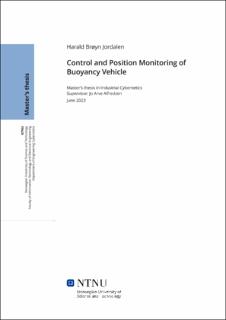| dc.contributor.advisor | Alfredsen Jo Are | |
| dc.contributor.author | Jordalen Brøyn Harald | |
| dc.date.accessioned | 2023-10-11T17:22:14Z | |
| dc.date.available | 2023-10-11T17:22:14Z | |
| dc.date.issued | 2023 | |
| dc.identifier | no.ntnu:inspera:140443607:29500064 | |
| dc.identifier.uri | https://hdl.handle.net/11250/3095905 | |
| dc.description.abstract | En små skale prototype av en oppdriftsenhet, engelsk kalt buoyancy vehicle og heretter forkortet
til BV. For undervannsaktivering har blitt produsert. BV er i stand til å endre sitt eget volum ved
hjelp av en stempelbasert forskyvningsmekanisme, som lar den justere tetthet og oppdriftskraft,
og endre sin vertikale bevegelse i vannsøylen. For å stabilisere enheten på en spesifikk dybde,
er en PID-kontroller implementert, som bruker stempelet som en aktuator og en trykksensor for
dybdemålinger. Ved å la BV drive horisontalt med vannstrømmen og overvåke posisjonen, kan BV
være et nyttig verktøy som en Lagrange-drifter for å måle data for havstrømmer under overflaten.
Målene i denne rapporten er følgende:
• Fullføre BV maskinvare- og programvaredesign.
• Finjustere BV kontrollsystem.
• Analysere BV operasjonelle rekkevidde ift. teoretisk sjøvannstetthet.
• Forberede et undervanns akustisk sporingssystem.
• Teste og verifisere BV og sporingssystemet i sjøprøver for å karakterisere fysisk ytelse og
begrensninger.
En matematisk modell er utviklet i Matlab/Simulink for å analysere BVs ytelse og begrensninger
i forskjellige scenarier. Simuleringen kan også beregne forinnstillingen av enhetens ytre lokk, for
å forinnstille maksimum/minimum tetthet før et nyt dykk starter. Forinnstillingen av det ytre
lokket avhenger av tetthetsprofilen til vannet p ̊a stedet. Enheten er analysert i form av teoretisk
sjøvannstetthet (temperatur, saltholdighet og trykk), hvor det ble funnet at enheten kan oper-
ere i de fleste scenarier. Imidlertid kan tilstedeværelsen av ferskvann med lavere tetthet variere
tetthetsprofilen for mye, noe som reduserer hvor langt enheten klarer å dykke.
Sporingssystemet utnytter tidsforskjellen ved ankomst (TDoA) metoden for å overvåke BV’s posis-
jon under vann i sanntid. Sporingssystemet er bygd på en hydrofon og akustisk sender fra Thelma
Biotel, og en SLIM-modul for tidssynkronisering og posisjonsdata. Tidsstemplene og annen data
sendes til en datamaskin gjennom en ARF868 radio modem, hvor dataen behandles og posisjonen
(x, y, z) plottes i sanntid.
Både BV og sporingssystemet er verifisert gjennom fysiske eksperimenter. Kontrollsystemet til
enheten har blitt vellykket justert, noe som gjør at BV autonomt kan dykke til en forhåndsdefinert
dybde, holde seg nøytral i vannet, og returnere til overflaten når dykket er ferdig. Sporingssystemet
er verifisert ved å plassere in akustisk sender på en kjent plass og analysere den beregnede posisjonen
i forrhold til den faktiske posisjonen. Både BV og sporingssystemet viser lovende resultater og
muliggjør systemets evne til å opperere som en Lagrangian drifter, ett verdifult verktøy for måling
av undervanns hav strømninger. | |
| dc.description.abstract | A small-scale prototype buoyancy vehicle (BV) for underwater actuation has been made. The BV is capable of changing its own volume using a piston-based displacement mechanism, which allows it to adjust its density and buoyancy force, and change its vertical movement in the water column. To stabilize the BV at specific depths, a continuous feedback PID controller has been implemented, utilizing the piston as an actuator and a pressure sensor for depth measurements.
By letting the BV drift horizontally with the water flow and monitoring the position, the BV could be a valuable tool for measuring sub surface ocean current data as a Lagrangian drifter.
The goal of this project are the following:
Complete the BV hardware and software design.
Fine-tuning of BV control system.
Analyse BV operational range wrt. theoretical sea water density.
Prepare underwater acoustic tracking system.
Test and verify BV and tracking system in sea trials, to characterize physical performance and limitations.
A mathematical model has been developed in Matlab/Simulink for analysing the BV performance and limitations in various scenarios. The simulation is also able to calculate the presetting value of the outer lid of the vehicle, for presetting the maximum/minimum density of the vehicle before starting a new dive. Presetting of the outer lid is dependent on the density profile at the target location.
The vehicle has been analyzed in terms of theoretical seawater density (temperature, salinity, and pressure), where it was found that the vehicle is able to operate in most scenarios. However, with the presence of lower-density fresh water, the density profile of the target location could be wary too much, reducing the vehicle's capability for diving.
The tracking system utilizes the time difference of arrival (TDoA) method for real-time position monitoring of the BV position underwater. The tracking system are built upon hydrophone and acoustic transmitter from Thelma Biotel, and a SLIM module for time synchronization and positional data. Timestamps and other data are sent to a host computer through an ARF868 radio modem, where the data is processed and the positions (x,y,z) are plotted in real time.
Both BV and tracking system have been validated through physical experiments. The control system of the vehicle has been successfully tuned, enabling the vehicle to autonomously dive to a predefined depth, remain neutrally buoyant, and return to the water surface when the dive is finished. The implementation of IMU reveals stable behavior of the vehicle in water during a dive. The tracking system has been tested by placing an acoustic receiver at a known location and analyzing the calculated position. Both the BV and tracking system reveals promising results, enabling the BV to be used as a Lagrangian drifter, and a valuable tool for measuring sub sea current flow at various depths. | |
| dc.language | eng | |
| dc.publisher | NTNU | |
| dc.title | Control and Position Monitoring of Buoyancy Vehicle | |
| dc.type | Master thesis | |
